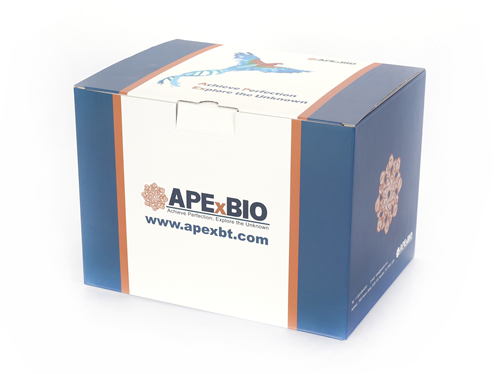HA14-1
HA14-1 is a potent small-molecule inhibitor of B-cell lymphoma 2 (Bcl-2), a protein factor binding to and inactivating pro-apoptotic proteins (such as Bax and BH3-only family proteins) to suppress apoptosis, that potently inhibits the anti-apoptotic of Bcl-2 and induces apoptosis with values of 50% inhibition concentration IC50 ranging from 10 to 20 μM in NIH3T3, HL60 and lung cancer H1299 cell lines. HA14-1 binds to Bcl-2 by mimicking the BH3 domain required for homo- and hetero-dimer formation and hence prevents the binding of these proteins subsequently resulting in the inhibition of Bcl-2. HA14-1 has been widely investigated in studies of apoptosis, which potentiates it to be used for the treatment of cancer.
Reference
Chen J, Freeman A, Liu J, Dai Q, Lee RM. The apoptotic effect of HA14-1, a Bcl-2-interacting small molecular compound, requires Bax translocation and is enhanced by PK11195. Mol Cancer Ther. 2002 Oct;1(12):961-7.
Niino S, Nakamura Y, Hirabayashi Y, Nagano-Ito M, Ichikawa S. A small molecule inhibitor of Bcl-2, HA14-1, also inhibits ceramide glucosyltransferase. Biochem Biophys Res Commun. 2013 Apr 5;433(2):170-4. doi: 10.1016/j.bbrc.2013.02.052. Epub 2013 Feb 26.
| Physical Appearance | A solid |
| Storage | Desiccate at -20°C |
| M.Wt | 409.23 |
| Cas No. | 65673-63-4 |
| Formula | C17H17BrN2O5 |
| Solubility | insoluble in H2O; ≥20.45 mg/mL in DMSO; ≥41.53 mg/mL in EtOH with ultrasonic |
| Chemical Name | ethyl 2-amino-6-bromo-4-(1-cyano-2-ethoxy-2-oxoethyl)-4H-chromene-3-carboxylate |
| SDF | Download SDF |
| Canonical SMILES | CCOC(=O)C1=C(OC2=C(C1C(C#N)C(=O)OCC)C=C(C=C2)Br)N |
| Shipping Condition | Small Molecules with Blue Ice, Modified Nucleotides with Dry Ice. |
| General tips | We do not recommend long-term storage for the solution, please use it up soon. |
| Cell experiment [1-3]: | |
|
Cell lines |
HL-60 cells, follicular lymphoma B cell lines, HF1A3, HF4.9 and HF28RA cells |
|
Preparation method |
The solubility of this compound in DMSO is >20.5 mg/mL. General tips for obtaining a higher concentration: Please warm the tube at 37 ℃ for 10 minutes and/or shake it in the ultrasonic bath for a while. Stock solution can be stored below -20℃ for several months. |
|
Reacting condition |
50 μM, 4 h |
|
Applications |
In HL-60 cells, HA14-1 induced cell death in a dose-dependent manner. HA14-1 (50 μM) caused the loss of viability in more than 90% of the cells. In HL-60 cells, treatment with 50 μM HA14-1 by 3 h displayed the characteristic pattern of DNA fragmentation. HA14-1 decreased cell viability and induced apoptosis in follicular lymphoma B cell lines, HF1A3, HF4.9 and HF28RA cells. HA14-1 (10-20 μmol/L) increased sensitivity of human glioblastoma cells to radiotherapy-induced apoptosis and chemotherapy-induced apoptosis. |
| Animal experiment [3]: | |
|
Animal models |
Swiss nude mice challenged with BeGBM cells |
|
Dosage form |
Intraperitoneal injection, 400 nM, once weekly from day 2 |
|
Application |
In Swiss nude mice challenged with BeGBM cells, HA14-1 (400 nmol, once weekly from day 2) did not have any significant effect on the growth of glioblastoma tumors in immunodeficient mice. HA14-1 (400 nM) increased the effect of the DNA-damaging agent etoposide (2.5 mg/kg) on glioblastoma growth in vivo. |
|
Other notes |
Please test the solubility of all compounds indoor, and the actual solubility may slightly differ with the theoretical value. This is caused by an experimental system error and it is normal. |
|
References: [1]. Wang J L, Liu D, Zhang Z J, et al. Structure-based discovery of an organic compound that binds Bcl-2 protein and induces apoptosis of tumor cells[J]. Proceedings of the National Academy of Sciences, 2000, 97(13): 7124-7129. [2]. Skommer J, Wlodkowic D, Mtt M, et al. HA14-1, a small molecule Bcl-2 antagonist, induces apoptosis and modulates action of selected anticancer drugs in follicular lymphoma B cells[J]. Leukemia research, 2006, 30(3): 322-331. [3]. Manero F, Gautier F, Gallenne T, et al. The small organic compound HA14-1 prevents Bcl-2 interaction with Bax to sensitize malignant glioma cells to induction of cell death[J]. Cancer research, 2006, 66(5): 2757-2764. | |
| HA14-1 is a non-peptidic ligand of a Bcl-2 surface pocket with IC50 of 9 μM | ||||||
| Targets | Bcl-2 | |||||
| IC50 | 9 μM | |||||
Quality Control & MSDS
- View current batch:
Chemical structure















